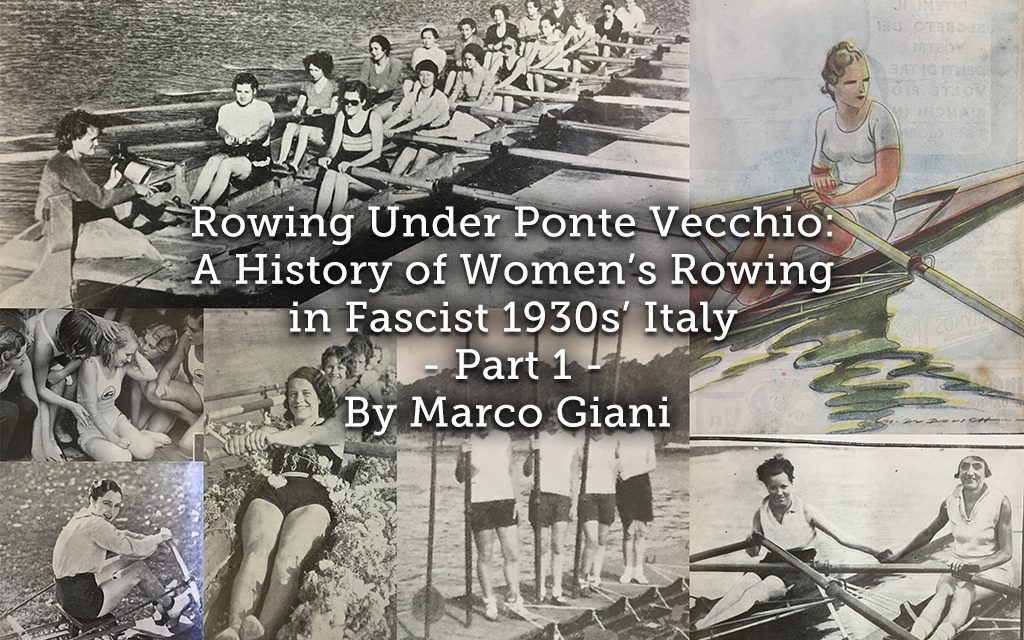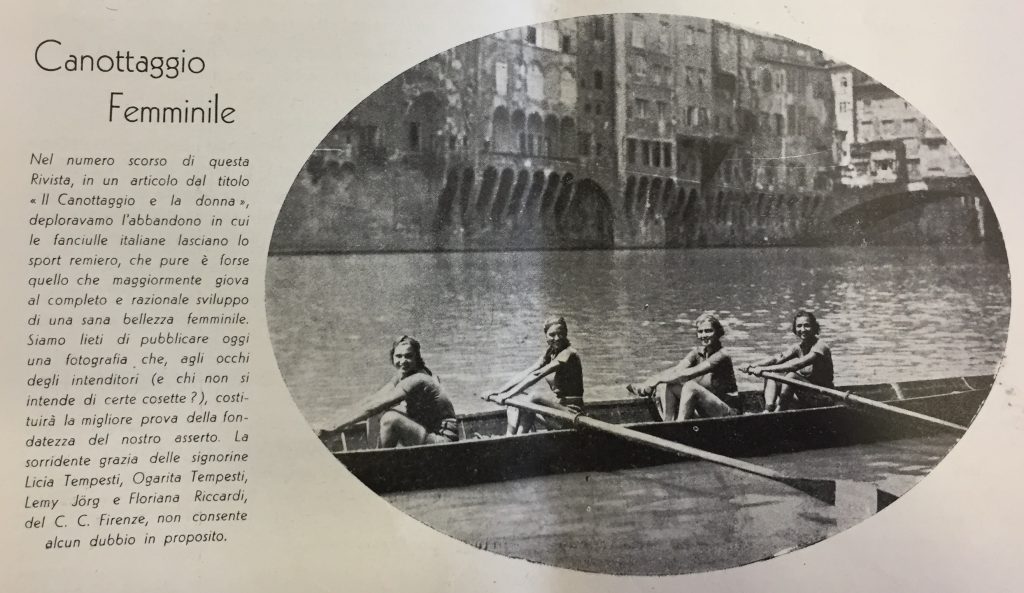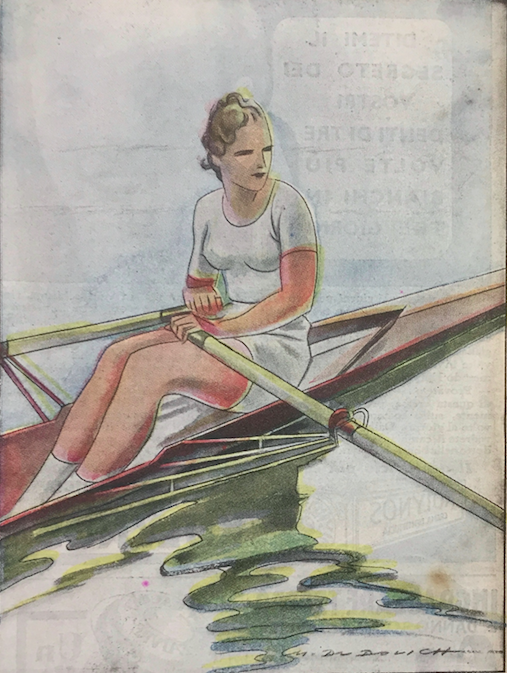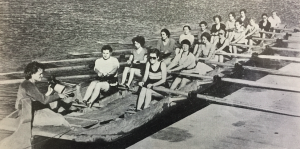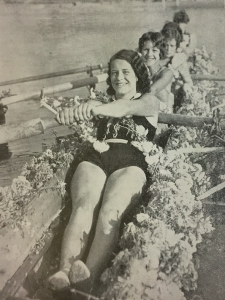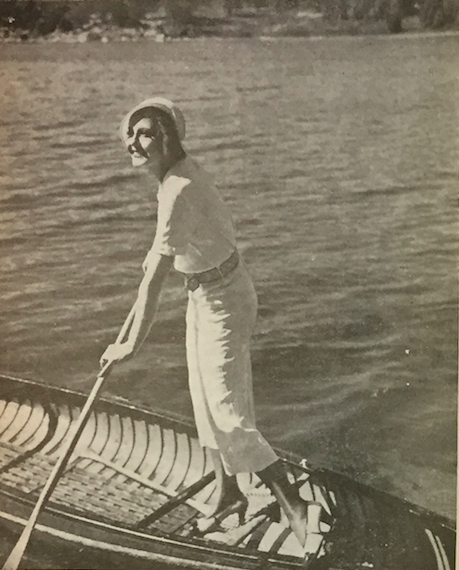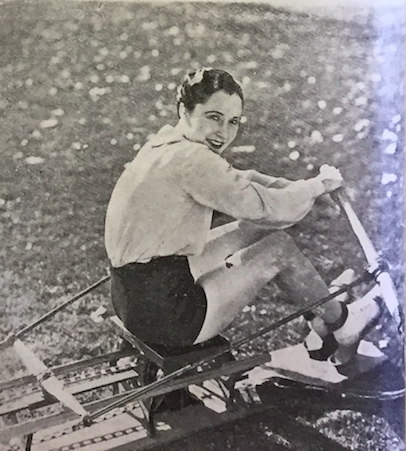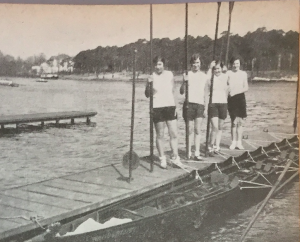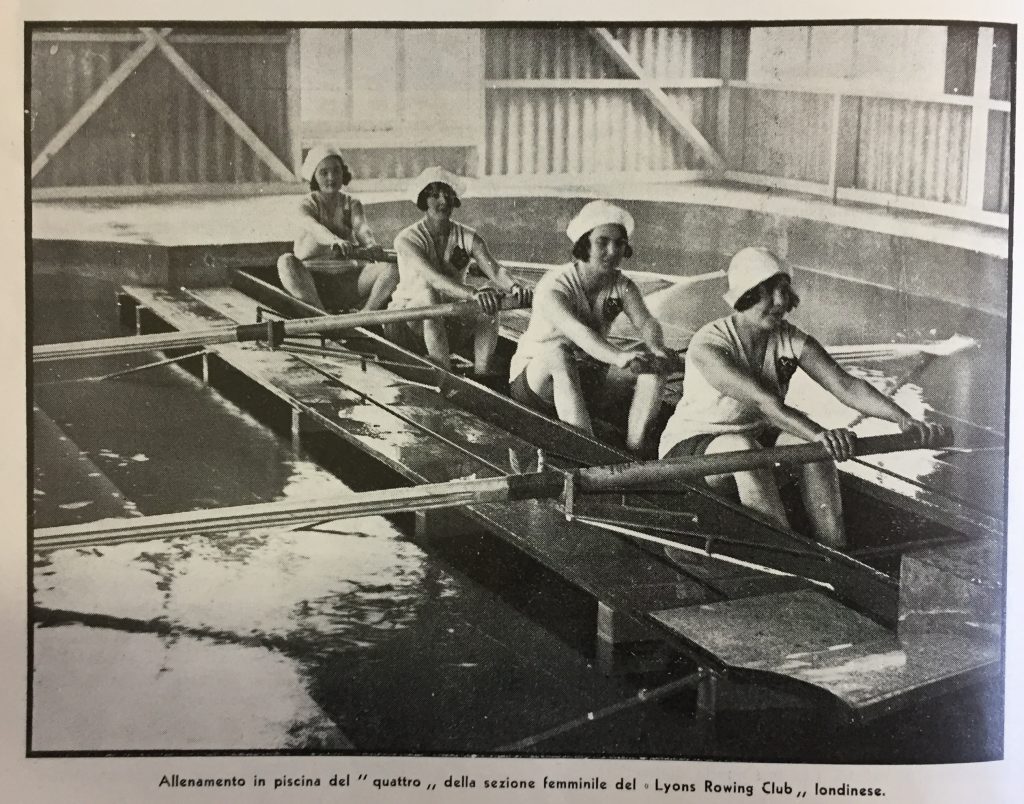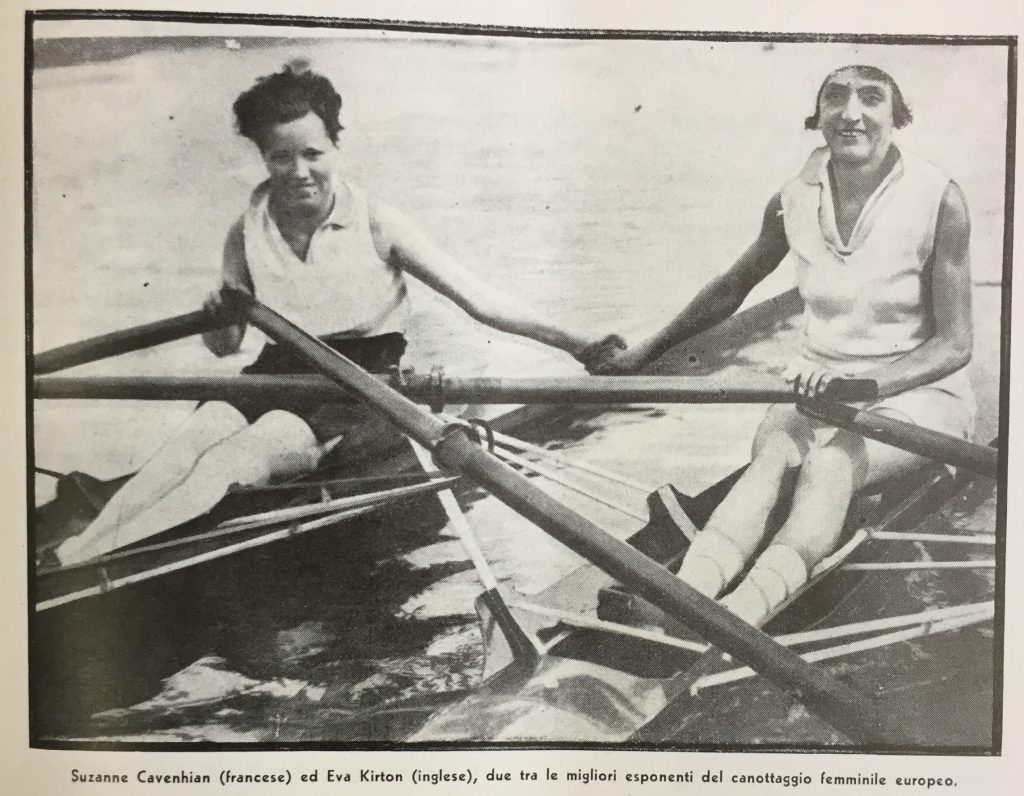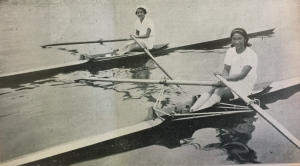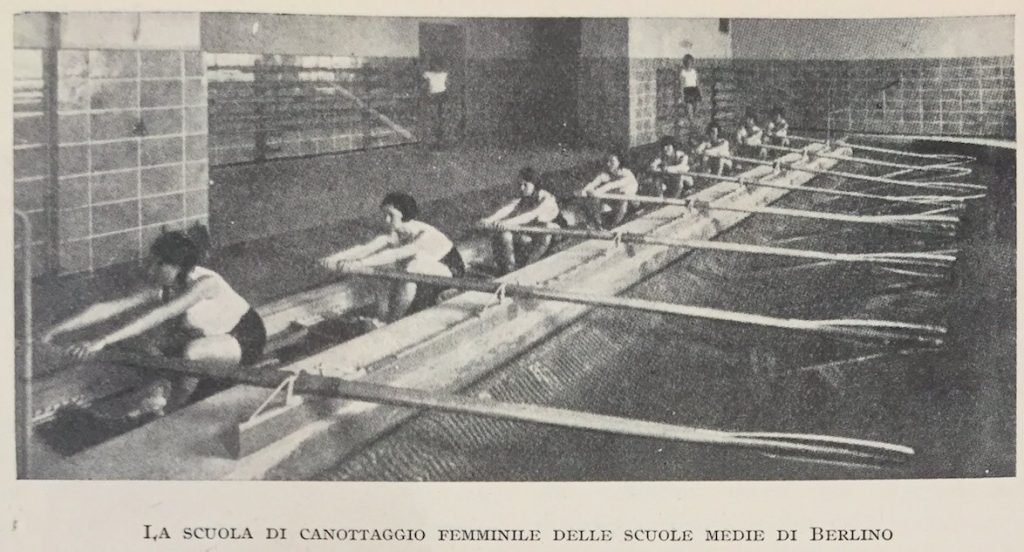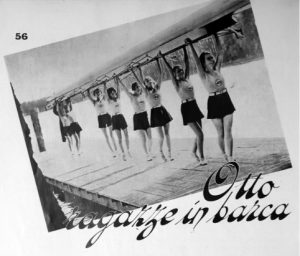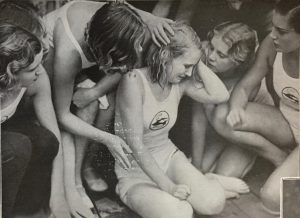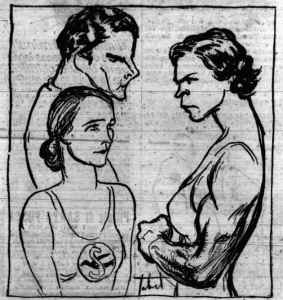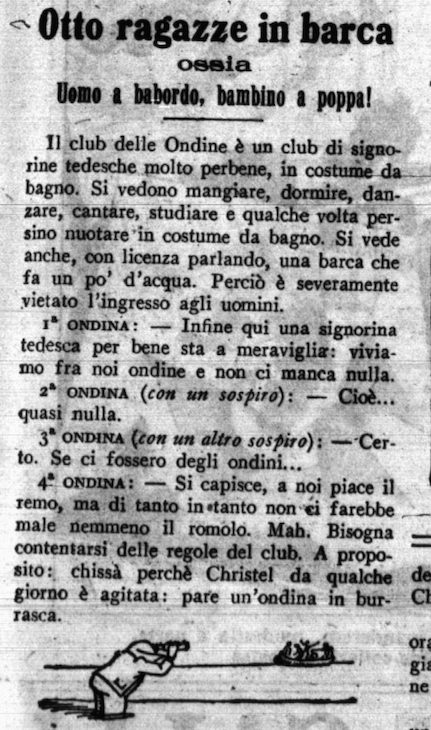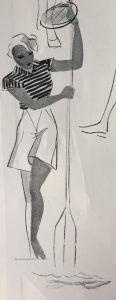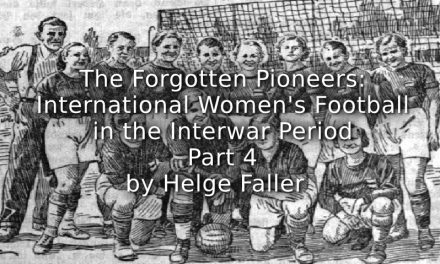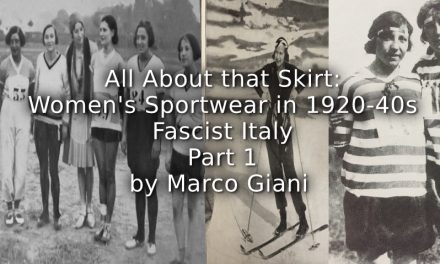The author wishes to express his special thanks to Rachel Mc Namara and Elisa Gallina for the linguistic review, and Lisa Taylor for a general review about rowing history
In a recent article published by Olimpia (the only Italian academic journal about Women’s Sports History), our author Marco Giani mentions women’s rowing in 1930’s Fascist Italy. Following the publication of that article, he decided not only to translate it into English for Playing Pasts’ readers, but also to extend it.
- 1. As evidenced in a letter sent to the Roman sports newspaper Il Littoriale (Rome), in autumn 1933 some girls were seen rowing, in Italy. It’s about time academics study the phenomenon of Italian female rowing during the Fascist Ventennio (1922/1943). An excellent starting point would be articles and above all images (pictures, and cartoons too) published by national press from that period. It’s not the aim of this Playing Pasts’ article to provide an in-depth study, but rather it is an invitation to rowing scholars to look further into this interesting topic in women’s sports history.
-
The first picture of Italian girls rowing published by Il Canottaggio magazine, taken on the river Arno, in front of Ponte Vecchio, Florence, Summer 1933
Source: Il Canottaggio, August 1933, p. 27
- 2. What was happening with women’s canottaggio ‘rowing’ in Italy, in mid 1930s’? Unlike football and boxing, this female sport seemed to have an unusual status. It was not forbidden by the Fascist regime: for example, none wrote to the newspapers editors denouncing it and requesting that it be banned, as happened with football. At the same time, it was not promoted by the Fascist authorities, which were more interested in promoting athletics and swimming in order to gain as many medals as possible in the forthcoming 1936 Summer Olympics in Berlin. Furthermore, rowing seemed to be practised by a very small number of Italian girls (such as Milanese aviator Gaby Angelini). Probably, this latter fact worked in their favour, since it acted as a sort of camouflage: if no one spoke about canottaggio femminile, then female rowers were free to quietly practice their beloved sport. Fortunately, we have been granted some glimpses of these young women in action, as evidenced by the historical sources used for this article.
-
A work by Marcello Dudovich, one of the most important Italian illustrators in the 1930s
Source: La Tribuna Illustrata, 22/01/1933, p. 9
- 3.1. Before talking about the active side of rowing (that is, its practice), let’s talk briefly about the passive one (that is, its representation). In fact, broadly speaking, during the 1930s Italian newspapers and magazines had a positive view of women’s rowing, sharing it with their audience. Further evidence is seen in the fact that pictures of the sport coming from abroad (above all the US, the UK, Germany; and also France and Japan, too) were regularly published.
-
American rowers, from Long Beach, CA
Source: Il Canottaggio, June 1933, p. 21
-
American rowers. The original Italian caption focuses on the flowers, which are viewed as “female” elements
Source: Il Canottaggio, October 1933, p. 22
Sometimes it happened as result of magazines’ policy to publish all types of pictures depicting Hollywood stars, including images of them practising sports (rowing being one of them).
-
Nancy Carroll rowing
Source: Il Canottaggio, July 1933, p. 16
-
Hollywood actress Ann Christy training to row
Source: Il Canottaggio, July 1933, p. 16
Furthermore, in November 1933 Il Canottaggio (the official monthly magazine of FIC = Federazione Italiana Canottaggio ‘Italian Rowing Federal Association’), in an attempt to encourage a wider practise of the sport in Italy, published Il canottaggio femminile germanico, a 3-page translation of a French article about the German women’s rowing movement. The message was clear: Italian girls (and their male patrons in the rowing clubs) should not just look at these photos, but they should commit to do the same! For the same propaganda reason, Il Canottaggio not only published images of static pictures of rowers, but also: images of rowers in training, pictures of the international stars of women’s rowing; women’s rowing from “exotic” countries (from a 1930s’ Italian point of view, of course) such as Japan. Again: what were Italian girls waiting for?
-
German rowers
Source: Il canottaggio femminile germanico, Il Canottaggio, November 1933, p. 21
-
Training session at Lyons Rowing Club, London (UK)
Source: Il Canottaggio, February/March 1934, p. 30
-
Suzanne Cavenhian (France) and Eva Kirton (UK), depicted as «among the best members of the European women’s rowing movement
Source: Il Canottaggio, January 1934, p. 15
-
Original caption says: Miss Miyoko Saionji, winner of the Japanese women’s championship, individual category
Source: Il Canottaggio, November 1933, p. 13
In particular, the Berlin women’s school appears to charm Il Canottaggio editors: the existence of a specific school dedicated to women’s rowing, where students could improve their sports skills in an institutional environment, seemed an utopia in 1930s’ Fascist Italy, where the few female rowers had to wait for some selfless male rower to teach them …
A video by Istituto Luce (regime’s propaganda institute) about the Berlin women’s rowing school, entitled «Teaching rowing to women» (1936).
-
The Berlin women’s rowing school.
Source: Maternità ed infanzia, April 1934, p. 23
- 3.2. In addition, the Italian press gave great reviews for the German film Acht Mädels im Boot (1932), directed by Erich Waschneck. Otto ragazze in barca / Il club delle ondine (there were two Italian translations of the German title) was praised both for its enchanting setting, where the story of Christa and her rowing mates took place, and its ethereal representation of the rowing girls, which was markedly different from the sexualized representation seen in Hollywood women. A comparative study would be useful in order to understand whether or not Acht Mädels im Boot had an impact on the construction of a positive image of women’s rowing in Western culture in the Interwar period: it was translated into French also, and two years later Hollywood made a remake, entitled Eight girls in a boat (USA, 1934), directed by Richard Wallace.
-
This article is about a women’s sailing (not rowing) club in Germany, but a frame from the movie was used to get their readers’ attention …
Source: Lo Sport Fascista, August 1933, p. 56
-
Acht Mädels im Boot movie frame, published by an Italian magazine
Source: L’Illustrazione Italiana, 25/06/1933, p. 1005
-
The humoristic magazine Guerin Meschino published a parody of Acht Mädels im Boot. The illustrator depicted the difference between Christa, the gentle main character (who’s about to fall in love), and her manly headmaster, the keeper of sport values (and girls’ moral probity).
Source: Guerin Meschino, 02/07/1933, p. 9
-
The writer of Guerin Meschino parodies the sporty and sexually pure atmosphere in the first part of the film, which is only broken by the love encounter between Christa and her love interest. The Italian complete heading says: «Acht Mädels im Boot, that is, man to port, baby aft!». In the first lines of the dialogue among the ondine ‘rowers’, the 1st girl says: “We live here all by ourselves, and we aren’t missing anything”; 2nd: “(sighing) Mmmh … almost anything”; 3nd: “(sighing) Well, if there were some ondini ‘male rowers’ here …”; 4th: “Sure, we like our remo ‘oar’, yet sometimes we wouldn’t mind a romolo ‘man’ too. Never mind: we have to follow the club rules”. The wordplay on romolo is based on the double meaning of remo in Italian, which is ‘oar’ and ‘Remus’ (who, together with his brother Romulus, was the first founder of Rome)
Source: Guerin Meschino, 02/07/1933, p. 9)
- 3.3. Another clue to the growing interest of Italian newspapers in women’s rowing was the appearance of rower models in female fashion magazines: in fact, the publishing itself means that there were already some Italian women keen to practice rowing …
-
A female rower model
Source: La Donna, August 1933, p. 14)
- 3.4. A further clue was to this growing interest in women’s rowing can be see in the project plan designed for a new rowing club in Venice by Antonio Marchi (1935). The building plan specifically designated spogliatoio donne and docce donne, that is a changing room and shower room for women rowers. In the description the architect talks about «a separated female section for 50 women in a 45 meters squared area». Interestingly, if we compare the space assigned to women with that assigned to men (140 meters squared for 330 men), we can say that the space for women was in fact quite generous.
-
Interior of Antonio Marchi’s project plan
Source: A. Pica, Nuova architettura italiana, 1936, p. 334
- 3.5. One final clue can be seen in what Italian sports physicians and journalists wrote about female rowing from a medical perspective (which, in Fascist Italy, was a fundamental reason for female sports, due to the regime’ eugenic policy). Francesco Valagussa, in Maternità e Infanzia (March 1934), blamed mountain-climbing and skiing as over strenuous activities for women, praising instead tennis and rowing as sports that could promote general physical development and improve their respiratory system. Luigi Ferrario, one of the most important sport journalists at that time, praised rowing as a «very useful» female sport in an article published by La Domenica Sportiva (December 1932).
Article © Marco Giani
For Part 2 – bit.ly/2Ii81y6
For Part 3 – bit.ly/2Vsc7HR
References
- For Giani’s article about Il Littoriale’s letter (1933), see: https://www.academia.edu/37276268/_Cattoliche_fasciste_e_sportive_una_testimonianza_sulla_pratica_sportiva_femminile_1933_
- For Giani’s interview with Martha Specht speaking about her mother Flaminia Goretti De Flamini, see: https://www.academia.edu/37616935/Intervista_a_Martha_Specht_19_09_2018_
- For the textual transcriptions of the historical sources used for this article, see: https://www.academia.edu/37424933/Materiali_per_lo_studio_della_storia_del_canottaggio_femminile_in_Italia
- For more images published by Italian newspapers and videos broadcasted by Istituto Luce about women’s rowing abroad, see: https://twitter.com/calciatrici1933/status/1034180191613067266
- For more images about the movie Acht Mädels im Boot (1932), and its Italian and French versions, see: https://twitter.com/calciatrici1933/status/979424718154616832
- For Antonio Marchi’s project plan, see: https://twitter.com/calciatrici1933/status/1085958627209474050
- For more pictures about Italian women’s rowing during the Ventennio, see: https://twitter.com/calciatrici1933/status/989561962295189505
- For a post on the 1942 Coppa Libellula (taken from the FIC official website), see: http://www.canottaggio.org/1_news/2018_2news/0709_realini.shtml
- For more pictures about rowing propaganda in Fascist youth (male & female) associations, see: https://twitter.com/calciatrici1933/status/1041285910648823808
- For more materials about Fascism and Italian male rowing during the Ventennio, see:https://twitter.com/calciatrici1933/status/1019350770100170757
- For pictures about Italian women’s sailing during the Ventennio, see: https://twitter.com/calciatrici1933/status/1037082169347330049

